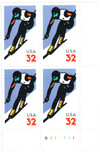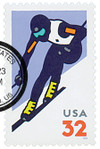
1998 32c Alpine Skiing
# 3180 - 1998 32c Alpine Skiing
$0.35 - $25.00
U.S. #3180
1998 32¢ Winter Sports
Alpine Skiing
1998 32¢ Winter Sports
Alpine Skiing
Issue Date: January 22, 1998
City: Salt Lake City, UT
Quantity: 80,000,000
Printed By: Banknote Corporation of America
Printing Method: Lithographed
Perforations: 11.2
Color: Multicolored
City: Salt Lake City, UT
Quantity: 80,000,000
Printed By: Banknote Corporation of America
Printing Method: Lithographed
Perforations: 11.2
Color: Multicolored
One of the most popular winter sports in the United States is Alpine skiing. This stamp was issued to celebrate the sport and is, in fact, one of many U.S. stamps which feature skiing. Its graphic design captures the color, speed, and strength of the Alpine skier. The stamp is intended to honor the more than nine million active skiers in this country, the best of whom are expected to participate in the 1998 Winter Olympics in Nagano, Japan.
Alpine, or downhill skiing, is popular as both a recreational and competitive sport. The term Alpine comes from the name for the European mountains, the Alps. The sport was probably introduced in the U.S. in the mid-1800s by Norwegian immigrants, at about the same time organized skiing competition was beginning in Norway.
Alpine competitions consist of different events. In the downhill, competitors race down steep slopes at speeds of about 60 miles per hour. Slalom skiers test their skills in high-speed turning. They must pass through pairs of numbered flags, called gates, as they race down a twisting course. Other races, like the giant slalom and super giant slalom, combine elements of both the downhill and slalom courses. There is also a combined competition that actually consists of the two separate races.
U.S. #3180
1998 32¢ Winter Sports
Alpine Skiing
1998 32¢ Winter Sports
Alpine Skiing
Issue Date: January 22, 1998
City: Salt Lake City, UT
Quantity: 80,000,000
Printed By: Banknote Corporation of America
Printing Method: Lithographed
Perforations: 11.2
Color: Multicolored
City: Salt Lake City, UT
Quantity: 80,000,000
Printed By: Banknote Corporation of America
Printing Method: Lithographed
Perforations: 11.2
Color: Multicolored
One of the most popular winter sports in the United States is Alpine skiing. This stamp was issued to celebrate the sport and is, in fact, one of many U.S. stamps which feature skiing. Its graphic design captures the color, speed, and strength of the Alpine skier. The stamp is intended to honor the more than nine million active skiers in this country, the best of whom are expected to participate in the 1998 Winter Olympics in Nagano, Japan.
Alpine, or downhill skiing, is popular as both a recreational and competitive sport. The term Alpine comes from the name for the European mountains, the Alps. The sport was probably introduced in the U.S. in the mid-1800s by Norwegian immigrants, at about the same time organized skiing competition was beginning in Norway.
Alpine competitions consist of different events. In the downhill, competitors race down steep slopes at speeds of about 60 miles per hour. Slalom skiers test their skills in high-speed turning. They must pass through pairs of numbered flags, called gates, as they race down a twisting course. Other races, like the giant slalom and super giant slalom, combine elements of both the downhill and slalom courses. There is also a combined competition that actually consists of the two separate races.












